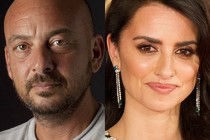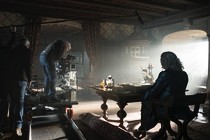Golden Door
- The surprise hit of the Venice Film Festival begins realistically before moving into a visionary realm
Emanuele Crialese prefers legend to realism "because it leaves more room for the imagination". Yet the images of the humiliating intelligence tests to which US immigration officials subject Italians, Greeks, the French and Spanish in his new film Golden Door [+see also:
trailer
interview: Alexandre Mallet-Guy
interview: Charlotte Gainsbourg
interview: Emanuele Crialese
interview: Emanuele Crialese
interview: Fabrizio Mosca
film profile], in competition at Venice, have a painful historical concreteness.
The Sicilian family that the director of Respiro: Grazia’s Island [+see also:
trailer
film profile] follows on its journey to the "golden door" of Ellis Island – the small island facing Manhattan that since 1894 has been the first point of arrival for over 15 million immigrants – most likely represents the emancipation and letting go of one’s own cumbersome roots and has many autobiographical elements (Crialese was born in Sicily and at the age of 26 moved to the US to work).
However, the director also spent a year studying the documents and procedures that were applied in the first 20 years of the 20th century on the island. Not simply a place where immigrants were welcomed and sorted, Ellis Island was a true “laboratory-archive" in which the applied “science” of eugenics represented a mechanism aimed at standardising the nation (numerous laws immigration and marriage laws flourished in those years in the US, and those branded as “degenerate” and "unproductive" were forcibly sterilised).
Thus, history and personal transformation are the principal elements of a film that begins with images of an early 20th-century, backwards Sicily ruled by superstition, in which the colours of the earth and rocks blend with those of it inhabitants. It then moves to the ocean, for the four-week voyage in steerage – storage spaces used as sleeping cabins, without toilet facilities – before arriving at the “Island of Tears", the last step towards the New World.
The river of milk in which the film’s main characters (Charlotte Gainsbourg and Vincenzo Amato) dream of swimming is the amniotic fluid of a Mother America capable of nourishing all of its adopted sons and daughters, but it is above all the unstoppable stream that pushes people to seek out the new, abandon barren lands, run from the arcane and recreate themselves.
The idea for The New World came about many years ago, when Martin Scorsese’s producer Robert Chartoff gave Crialese $5,000 to write a screenplay, which went through numerous versions before becoming the current Italian/French co-production.
After a four-week shoot in Sicily, the crew travelled to Argentina, where Ellis Island was recreated in the Immigrants’ Hotel in the port of Buenos Aires, a dilapidated building resounding with memories from long ago. But this is another story.
(Translated from Italian)
Did you enjoy reading this article? Please subscribe to our newsletter to receive more stories like this directly in your inbox.




















